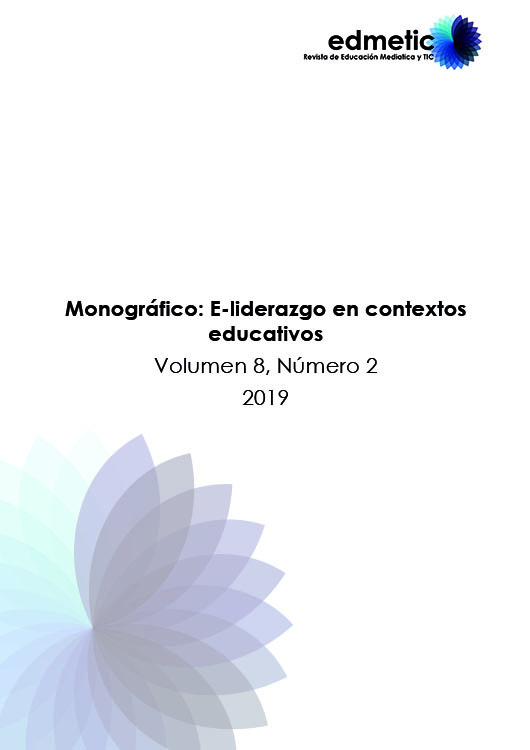Análisis de dos webs para el aprendizaje de idiomas: actividades para reforzar la expresión oral
Main Article Content
Abstract
Downloads
Article Details
TRANSFER RIGHTS AND COMMITMENTS TO EDMETIC, REVISTA DE EDUCACIÓN MEDIÁTICA Y TIC
E-ISSN: 2254-0059
The undersigned author(s) of article entitled:
- Transfer to EDMETIC, Revista de Educación Mediática y TIC publishing rights of the article mention before. The magazine will have the right to publish in any format or media this article.
- The author(s) claim that this article is original and which has not been published before in any format and wasn´t submitted for evaluation to another publication.
- The author(s) claim that this article has the copyright´s permissions for publication
- The author(s) accept the changes to the contents on the review, and changes in the style of the manuscript by the Editorial Board of EDMETIC, Revista Educación Mediática y TIC.
- The author(s) declare that they have complied with the ethical principles of research.
- The author(s) not be subject to personal or business association that involves a conflict of interest with article presented
- El author(s) undertakes to give the primary sources of information, if requested.
Date:
Author(s) names and signatures (1):
(1) Fill the form and send to: revistaedmetic@uco.es
References
ANDERSON, P. (2007). What is Web 2.0? Ideas, technologies and implications for education. JISC Technology and Standards Watch, 1 (1), 1-64. Recuperado de: http://21stcenturywalton.pbworks.com/f/What%20is%20Web%202.0.pdf
CHACÓN, C. T., & PÉREZ, C. J. (2011). El podcast como innovación en la enseñanza del inglés como lengua extranjera. Píxel-Bit. Revista de Medios y Educación, (39), 41-54.
CHARTRAND, R. (2012). Social networking for language learners: Creating meaningful output with Web 2.0 tools. Knowledge Management & E-Learning: An International Journal (KM&EL), 4(1), 97-101.
FACER, B. R., ABDOUS, M. H., & CAMARENA, M. M. (2009). The Impact of Academic Podcasting on Students' Learning Outcomes, 339-351. En R. de Cássia Veiga Marriott (Kristin Klinger). Handbook of research on e-learning methodologies for language acquisition. New York: Information Science Reference.
FERNÁNDEZ, M. y CEBREIRO, B. (2003). La integración de los medios y nuevas tecnologías en los centros y prácticas docentes. Pixel-Bit. Revista de Medios y Educación. 20, 33-42.
GARCÍA CARBONEL, R. (1998) Nuevas técnicas de la Comunicación Escrita. Madrid: Editorial EDAF, S.A.
GARCÍA SALINAS, J., FERREIRA CABRERA, S., & MORALES RÍOS, S. (2012). Autonomía en el aprendizaje de lenguas extranjeras en contextos de enseñanza mediatizados por la tecnología. Onomázen, 25, 15-50.
GIL PALLARÉS, M. (2014). Aprender a aprender inglés con las nuevas tecnologías: Enseñanza del inglés mediante las TICS en educación primaria. Una propuesta didáctica para la Educación Primaria. Trabajo Fin de Máster. Castellón, España: Universidad Jaume I de Castellón.
HINKELMAN, D. (2004). EML and implications for task design in blended L2environments. Proceedings of CLaSIC. Recuperado de: http://www.paccall.org/past_events/2004proceedings_papers/hinkelman1.pdf
HURTADO MONTESINOS, M. D., & DÍAZ CARCELÉN, L. (2009). Tema 8: Tecnologías para la enseñanza-aprendizaje de la lengua extranjera. En F. J. Solo Pérez, y M. D. Hurtado Montesinos, Tecnologías de apoyo y atención a la diversidad (pp. Tema 8). Murcia: Universidad de Murcia.
IBÁÑEZ, A., JORDANO, M., & VERMEULEN, A. (2016). Diseño y evaluación de VISP, una aplicación móvil para la práctica de la competencia oral. RIED: Revista Iberoamericana de Educación a Distancia, 19(1), 63-81. doi: 10.5944/ried.19.1.14580.
ISTIFCI, I., LOMIDAZDE, T., & DEMIRAY, U. (2011). An effective role of e-learning technology for English language teaching by using meta communication actors. Turkish Online Journal of Distance Education-TOJDE. 12 (4), 1-5. doi: 10.1109/ICAICT.2011.6110951.
JORDANO, M. (2011). La enseñanza aprendizaje de la competencia oral en lengua extranjera en el contexto de la educación abierta y a distancia: de la casete a la interacción virtual. RIED. Revista Iberoamericana de Educación a Distancia, 14 (1), 15-39. doi: 10.5944/ried.1.14.798.
KIM, S. H. (2014). The effects of using storytelling with a Charlie Chaplin silent movie clip on oral proficiency development. Stem Journal, 15(1), 1-20.
STEVENSON, M. P., & LIU, M. (2010). Learning a language with Web 2.0: Exploring the use of social networking features of foreign language learning websites. CALICO Journal, 27(2), 233-259.
THORNE, S. L., & REINHARDT, J. (2008). "Bridging activities," new media literacies, and advanced foreign language proficiency. CALICO Journal, 25(3), 558-572.
TRAVIS, P., & JOSEPH, F. (2009). Improving learners' speaking skills with podcasts, 313-330. En M. Thomas (Kristin Klinger). Handbook of research on Web 2.0 and second language learning. New York: Information Science Reference.
VOGEL, T. (2001) Learning out of control: Some thoughts on the World Wide Web in learning and teaching foreign languages, 155–179. En A. Chambers y G. Davies(eds.). Information and Communications Technology: A European Perspective. Lisse: Swets & Zeitlinger.
WANG, S., & VÁSQUEZ, C. (2012). Web 2.0 and second language learning: What does the research tell us?. CALICO Journal, 29(3), 412-430.
WARSCHAUER, M. (ed.) (1996). Virtual connections: online activities and projects for networking language learners. Honolulu, HI: University of Hawaii Second Language Teaching and Curriculum Center.
WARSCHAUER, M., & GRIMES, D. (2007). Audience, authorship, and artifact: The emergent semiotics of Web 2.0. Annual Review of Applied Linguistics, 27, 1-23. doi: 10.1017/S0267190508070013.
WESCH, M. (2007). Web 2.0: The machine is using us [Video]. Revisado agosto 19, 2018, de: http://www.youtube.com/watch?v=6gmP4nk0EOE
